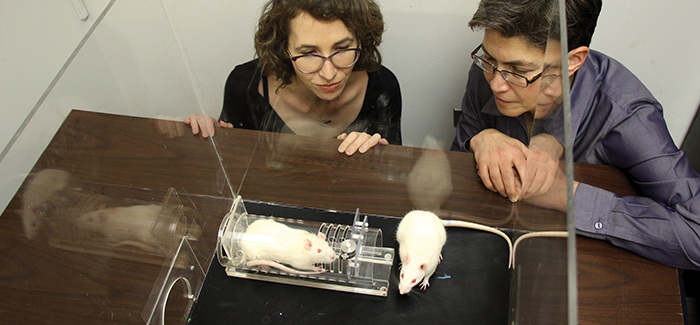
Inbal Ben-Ami Bartal (left) and Peggy Mason (right) demonstrated for the first time that empathy is not unique to humans. (Photography by Kevin Jiang)
Spotlight
The lowly rat got a much-needed reputation boost when a team of UChicago researchers discovered the rodents demonstrate empathy and helping behavior.
Inbal Ben-Ami Bartal, AM’09, PhD’12, (Psychology), was the lead author of two studies in which rats learned to use a tricky door mechanism to free a trapped cage mate. The interdisciplinary team also included Jean Decety, the Irving B. Harris Professor in Psychology and the College, and Peggy Mason, professor of neurobiology. In the studies, Bartal trapped one rat in a restrainer and observed the reaction of its cage mate. She observed that free rats showed signs of distress at the plight of their companions and worked hard to free them by learning to open the restrainer.
“We’re raised and educated with this notion that people are born with this animalistic drive for aggression and dominance,” says Bartal, now doing a three-year fellowship at UC Berkeley’s Miller Institute for Basic Research in Science. “There’s something so encouraging in finding out that this kind of empathic behavior and pro-social behavior is not something that goes against nature.”
Why study empathy in rats?
Like all science, it didn’t really end up being what I planned. My original idea was related to how food sharing would be influenced by stress. I went down to animal facilities and put a restrainer inside a cage and trapped one of the rats, just to test it out. I noticed that the rat’s cage mate was kind of going berserk. That’s a basic form of empathy: just being able to recognize the fact that this trapped rat was distressed and getting a similar emotional response.
It occurred to me that it really looked like the free rat was trying to get the trapped rat out. Designing a restrainer that the free rat could potentially learn to open would provide an example of helping behavior in rats.
How did you feel while running these experiments?
Seeing those rats so disturbed by the plight of their fellow rats was very moving. One of my undergrads told me that I looked like I was watching a suspense film. I would sit there for days on days and watch them: are they going to learn to open it?
What do other scientists think of your research on helpful rats?
In previous decades, when people were working with animal models, there was a lot of criticism of anthropomorphism. That criticism shut down research that connects psychological experience to biology in animals. As a result, the field has been missing out, because there’s so much you can learn: models of mental illness in rats have led to serious advances in medicine and producing drugs that help people.
There is a need for people to be more accepting of this type of integrative work. I had the luck of having amazing and supportive mentors and help from talented students. Most people would have laughed me out of the lab if I proposed looking at empathy at rats.
This interview has been edited and adapted for Dialogo.
